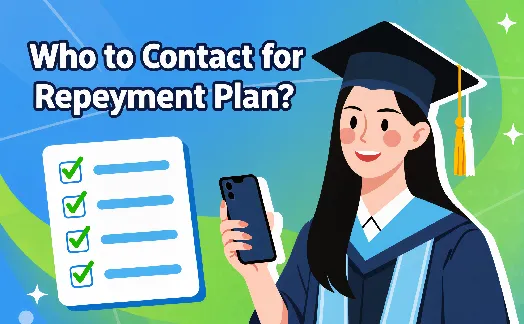Updated Guide: Everything you need to know about contacting the right people when it’s time to enroll in a student loan repayment plan.
Introduction
Managing student loans can be overwhelming. One of the most important decisions you’ll make as a borrower is enrolling in the right repayment plan. Whether you’re graduating, ending your grace period, or simply seeking a more affordable monthly payment, knowing who to contact at the right time can save you stress, money, and potential penalties.
This article walks you through, step by step, who you should reach out to, how to prepare, and what to expect during the process. It’s designed as a practical guide for U.S. federal student loans, but the principles apply broadly to most types of loans.
Understanding Repayment Plans
Before contacting anyone, it’s important to know what repayment plans are available. Repayment plans determine how much you pay each month and how long it will take to pay off your loans. Federal student loans offer several repayment plans including:
- Standard Repayment Plan: Fixed payments over 10 years.
- Graduated Repayment Plan: Lower payments at first, increasing every two years.
- Extended Repayment Plan: Longer repayment terms for larger balances.
- Income-Driven Repayment (IDR) Plans: Payments based on income and family size, such as SAVE (formerly REPAYE), PAYE, IBR, and ICR.
Each plan has different eligibility criteria and pros and cons. Understanding your options will help you ask the right questions when you contact your servicer.
Who You Should Contact First
The primary point of contact for enrolling in or changing your repayment plan is your loan servicer. A loan servicer is a company assigned by the Department of Education (or your private lender) to manage your loan. They handle billing, payments, and customer service.
For federal student loans, you can find your servicer by logging into your account at studentaid.gov and checking the “My Loan Servicers” section.
Some of the major federal loan servicers include:
- MOHELA
- Aidvantage
- Edfinancial Services
- Nelnet
- OSLA Servicing
Tip: Always use the official contact details provided on your loan account. Be wary of third-party companies that charge fees for services your servicer provides for free.
Step-by-Step: Enrolling in a Repayment Plan
- Log in to your loan account: Visit studentaid.gov for federal loans or your lender’s website for private loans.
- Identify your servicer: Look for their contact information (phone, email, online portal).
- Review repayment options: Use online calculators to compare plans. The Department of Education has a “Loan Simulator” tool that can estimate payments under each plan.
- Gather documents: For income-driven plans, you’ll need your most recent tax return or proof of income, family size, and other details.
- Submit your application: You can usually apply online via your servicer’s website or by mailing a paper form. Applying directly through studentaid.gov is recommended for IDR plans.
- Confirm enrollment: After submission, your servicer will review your application and notify you of your new payment amount and due date.
Contact Methods
Most servicers offer multiple ways to reach them:
- Phone: The fastest for urgent issues. Call during business hours for quicker service.
- Online Message Center: Log in and send a secure message.
- Mail: For official documents, certified mail is safest.
- Mobile App: Some servicers have apps for account management.
What to Ask When You Contact Your Servicer
Prepare a list of questions before calling or emailing:
- Which repayment plans am I eligible for?
- What’s my current interest rate and balance?
- What would my monthly payment be under each plan?
- How do I submit the required income documentation?
- When will the new plan take effect?
- Will changing plans affect my progress toward forgiveness programs?
Common Mistakes to Avoid
Borrowers often make these mistakes when enrolling in a repayment plan:
- Waiting until the last minute to apply, causing missed payments.
- Not updating contact info with the servicer.
- Failing to recertify income annually for IDR plans.
- Paying third-party companies unnecessary fees.
- Ignoring servicer notices or deadlines.
Extra Help: Who Else Can You Contact?
If you’re confused or having trouble with your servicer:
- Federal Student Aid Information Center (FSAIC): 1-800-433-3243 – offers general help.
- Ombudsman Group: Handles disputes if you’ve tried resolving an issue with your servicer unsuccessfully.
- Financial Aid Office at Your School: They can advise on the process and your obligations.
- Nonprofit Credit Counseling Agencies: Some offer free guidance on student loans.
Tips to Make the Process Easier
- Set reminders for deadlines like annual IDR recertification.
- Keep copies of all communications with your servicer.
- Use autopay to avoid missed payments (may also reduce interest by 0.25%).
- Check your credit report annually to ensure payments are reported correctly.
Repayment Plan FAQs
Do I have to contact my servicer to change plans?
Yes. Your servicer is the only entity authorized to process your repayment plan change.
Can I switch plans at any time?
Most plans allow you to switch at any time, but you may need to provide updated income information.
Does enrolling in an income-driven plan affect forgiveness programs?
It can help. Many forgiveness programs (like Public Service Loan Forgiveness) require being on a qualifying repayment plan such as an IDR plan.
How long does it take to process a repayment plan change?
Typically 2–4 weeks, but it can vary. Always submit early to avoid missed payments.
Conclusion
When it’s time to enroll in a repayment plan, your loan servicer is your main point of contact. By understanding your options, preparing documents, and asking the right questions, you can make the process smooth and stress-free. Always use official resources like studentaid.gov and never pay for services your servicer offers for free.
Taking the time to research and contact the right people now can save you thousands over the life of your loan — and give you peace of mind knowing your repayment plan fits your budget.
